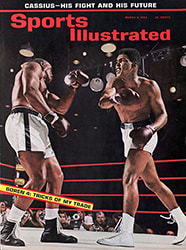
Cricket Made Easy, or at Least Possible
Miss Gertrude Jacobs does not look like a demon on the rules of sport. An ample woman in her middle years, with brown hair going haphazardly gray, she looks like Aunt Alice back home. And talks a little like her, too, breathlessly, elliptically, blue eyes regarding you through blue-rimmed glasses. But Miss Jacobs is a demon on the rules of sport, a woman who goes to ball games and raptly follows the performance of the umpire, so it is no particular wonder that she should be the woman who has broken the cricket barrier. Gertrude Jacobs has subdued the game of cricket to a series of filmstrips from which anyone can come away with a grasp of essentials and with no need to blanch even if a conversation turns to the ghastly question of leg before wicket.
The Peace Corps put her up to it. The Corps reasoned that closer relations would be possible with the peoples of former British possessions if its members could at least look at a cricket match intelligently. But cricket is not Parcheesi, with the rules set down on the inside of the top of the box. The rules did not seem to be set down anywhere, in a form intelligible to Americans, and cricketers were relatively few.
Miss Jacobs has an office at International House, which is a residence, a club, a social and study base for foreign students in the U.S. doing graduate work, and there the Peace Corps found her. She runs the Audio-Visual Workshop, taping languages and accumulating a picture and film library. But apart from this work at International House, she operates, singlehanded, a thing called the School Film Service, and one of the School Film Service's services is the making of filmstrips on game rules.
Her strips on baseball have been turned from film into books, have been translated into Japanese and will soon be put into Spanish. She has done basketball, Softball, hockey, badminton, field hockey and Little League rules. "In cricket, I found I had no place to begin because I had no vocabulary," Miss Jacobs said. "I would read, 'If you have an Aunt Sally on your team...' and I'd stop and think, now what in the world does Aunt Sally mean? A player who can't do anything, I found out, and a skier—pronounced sky-er—is a fly ball. Of course, that makes sense. Well, it all makes sense, after you know.
"New York is virtually a cricketless town," Miss Jacobs said sadly. "I thought if anybody would know about it Abercrombie & Fitch would, so I went down there and at least got to see what a bat looked like, and they gave me a little bitty rule book. But I finally had to get the bulk of my books from England. I had seen the name of Sir Donald Bradman used with such great respect for his playing ability that I figured if he was such a good player he must have written something. So I went and looked him up in the card index and there was a book. I tried the British and Australian consulates and the English-Speaking Union. They all knew about the book, but nobody had it, and I had to send to England. Nobody has ever read that book more carefully than I did. I cannot praise it too highly for anybody who's interested in cricket. There's never been another cricket player like him," Miss Jacobs said reverently. "Perhaps there won't be for a good long time. Now he is a broker, and I think he lives in Adelaide, Australia. No, I haven't written to him—I haven't had nerve enough to write to him."
But Miss Jacobs had resources other than Sir Donald and Abercrombie & Fitch. Her office, after all, was strategically located in a houseful of young Indians, West Indians, Scots, Australians—and she drafted them as technical experts. "They were skeptical at first," Miss Jacobs observed. "They thought it was just impossible for a beginner. One of the Indian boys, when I told him I was interested in cricket, said 'You!' as if it were the most hopeless thing in the world."
Miss Jacobs would descend upon the students at breakfast. "I'd just automatically move the salt and pepper into position for a match and say now, here's the pitch and here's the wicket. I'd usually get about an hour of cricket a morning. I could absorb just about enough a day for a new set of questions the next day. I deliberately didn't see any games at first. When I did see one, out on Staten Island, I didn't realize it was my first match. Because I knew what they were doing. I'd been studying it so hard and so intently that changing the salt and pepper shakers to men didn't seem to make much difference."
The filmstrips that resulted from all this are clear and rather charming. Appropriate old cricket prints precede the plunge into exposition; on strip one is a reproduction from London's Marylebone Cricket Club of The Laws of the Noble Game of Cricket.
"The Marylebone Cricket Club has been the central authority on the laws of cricket since 1787," Miss Jacobs said from behind the projector. "Look, that's all the rules there are. Isn't that amazing? But now there are whole books about them. You know, the rules have changed very little—sometimes there was no change for a period of a hundred years. Now here"—she was explaining another strip—"the batsman wears pads, and also the wicketkeeper. They protect everybody but the poor fielder. The umpires have worn those butcher's coats since before the dawn of Christianity, I guess.
"Now this is a normal field for an off-spinner. The captain has all these choices for the field, and they are only approximate. Sometimes you want them close in to the batsman, sometimes you want them way out. Now that position is called a silly mid-on because it's silly to stand there. He's apt to get hurt. Silly mid-off means he's standing in a very bad place up there on the off side of the batter.
"There's no such thing as a good ball or bad ball, in our sense, because the batsman doesn't have to hit at it."
It is hard on an American to be told that there is no such thing as a good ball or a bad ball; that a batsman may hit at a ball or not hit at it, as he likes; that if he should hit it he may run or not, as he likes; that a captain may place his fielders almost anywhere at all. It is hard for an American to discern a game in all this anarchy.
It is there, though, and it emerges from Miss Jacobs' filmstrips if you just don't get panicky and give up at the first appearance of difficulty. "Cricket should stand on its own in this country," said Miss Jacobs warmly. "It's a good game, and a highly sophisticated one. If Americans take it up, I hope they don't change it too much. If they did take it up, the first thing they would do would be to put gloves on the fielders. That ball is very, very hard, and it goes very, very fast. If you try for it, you stand a chance of breaking your fingers, so what do you do, you let it go. Another thing, Americans would wear short sleeves. The British wear long sleeves and roll them up. Now why, who knows, but short sleeves would not be cricket." Miss Jacobs allowed herself this. "Instead of white trousers, creams are the thing to wear. It's such a polite game. It's a game of gentlemen.
"I've been to South America and Manchuria and Japan," Miss Jacobs said. "Now I'd like to go to Australia, to meet Sir Donald Bradman. And I'd like to go to England to see a cricket match."
Born in Dennison, Ill., Miss Jacobs began as a physical education major at the University of Wisconsin; she changed her mind and added English and comparative literature, but went to Columbia University to do graduate work in physical education. She taught it for a number of years, in high schools, colleges, community recreation programs and various other places, including, in 1939, Yen Ching University in Peking, China.
"I thought when I went over to China that I'd have to find a good branch of a tree to cut off for a baseball bat, but I found they had beautiful equipment. And their modern dance was far superior to ours. I had only about 15 students—girls, though it was mixed for folk dancing. English folk dancing was most acceptable, because there was less physical contact—you know, ladies' chain, and all that."
Miss Jacobs' first filmstrip arose out of this trip. It was a strip called Dee Dee Chou, or Little Brother Chou, "made about the children in my little garden in China. I was just there, in my little old teahouse, and I taught them nursery rhymes and how to count. I taught them Ten Little Indians, and they put it into Chinese. And I did an audacious thing," Miss Jacobs said. "I did a film strip on the Chinese language. Sub-ABC level," she added hastily. "I took some of the words apart, looking at them as a foreigner would; I had a beautiful calligrapher. You can almost figure out what a word means if you know all the basic pictographs."
Miss Jacobs went from China to Berkeley, Calif. to New York and South Orange, N.J. teaching physical education. Then in 1945 she decided that that was not what she wanted to do. So "I sat down in the middle of my living room floor with my shoes off—that always helps me think. I knew I didn't want to go on teaching. I wanted to do some sort of creative work, and I wanted to travel, and I wanted to meet people doing interesting things."
Miss Jacobs got up off the floor and went full time into the making of film-strips.
In addition to further strips she has planned, the language tapes and picture collection at International House, Miss Jacobs is learning to develop her own Ektachrome film, putting the cricket strips into Hindi, taking a course at Columbia and has several other projects she is not ready to disclose.
Questioned as to how she plans and accomplishes more than, obviously, is possible, Miss Jacobs says, "I don't waste time. Things are pretty much on schedule and disciplined, which I don't like." A curious statement, but definitive of the lady.
PHOTO

